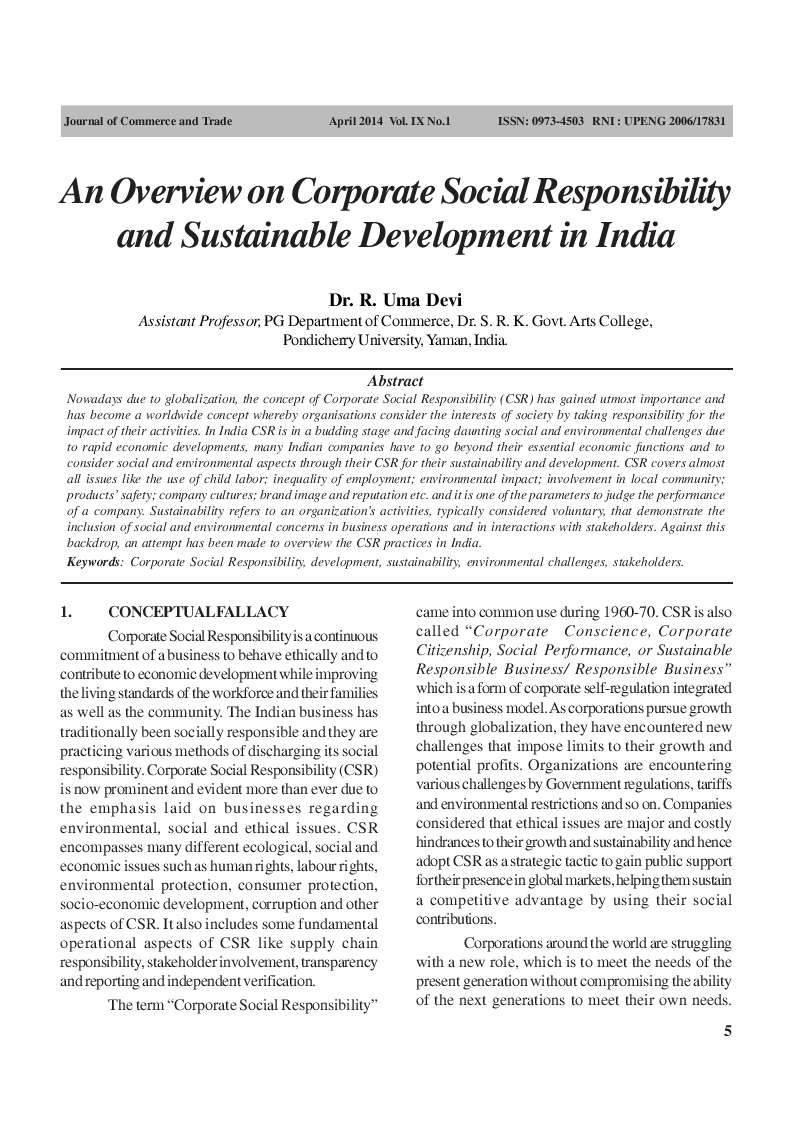An overview on corporate Social Responsibility and Sustainable Development in India
DOI:
https://doi.org/10.26703/jct.v9i1.143Keywords:
Corporate Social Responsibility, Sustainability, Environmental Challenges, IndiaAbstract
Nowadays due to globalization, the concept of Corporate Social Responsibility (CSR) has gained utmost importance and has become a worldwide concept whereby organisations consider the interests of society by taking responsibility for the impact of their activities. In India CSR is in a budding stage and facing daunting social and environmental challenges due to rapid economic developments, many Indian companies have to go beyond their essential economic functions and to consider social and environmental aspects through their CSR for their sustainability and development. CSR covers almost all issues like the use of child labor; inequality of employment; environmental impact; involvement in local community; products’ safety; company cultures; brand image and reputation etc. and it is one of the parameters to judge the performance of a company. Sustainability refers to an organization’s activities, typically considered voluntary, that demonstrate the inclusion of social and environmental concerns in business operations and in interactions with stakeholders. Against this backdrop, an attempt has been made to overview the CSR practices in India.
Downloads
Metrics
References
Androif & McIntosh (2005) “Having, Giving, and Getting: Slack Resources, Corporate Philanthropy, and Firm Financial Performance.” Business and Society 43, 135–161.
Arora, B. and Puranik. (2004), “A Review of Corporate Social Responsibility in India”, Development, 47 (3), pp.93-100.
Baker, Mallen. ”Arguments against Corporate Social Responsibility”. Business Respect. Retrieved 2008-03-07.
Blowfield Michael & Murray Alan, (2008), Corporate Responsibility: A Critical Introduction Publisher: Oxford University Press, USA (March 15, 2008)
Bruhman (2006). Social Entrepreneurship: The Art of Mission-Based Venture Development. New York: John Wiley & Sons.
Byron, Ellen. “Corporate Governance (A Special Report): Managers: Keep Out: Independent Directors Have a Lot More Power These Days, and a Lot More Responsibility.” Wall Street Journal, 21 June 2004.
Carroll, A. (1998). “The Four Faces of Corporate Citizenship”. Business and Society Review. September, vol. 100, no. 1, pp. 1–7
Carroll, A. B. (1999) ‘Corporate Social Responsibility: the evolution of a definitional construct’ Business and Society 38(3): 268-295.
Carroll, A.B., and A.K. Buchholtz. Business and Society: Ethics and Stakeholder Management. 5th ed. Australia: Thomson South-Western, 2003.
Centre for Social Markets (2001), “Corporate Social Responsibility: Perception of Indian Business, retrieved on 5th January 2009 from http://www.csmworld.org.
Corporate Social Responsibility Practices in India, Times Foundation, The corporate social responsibility wing of the Bennett, Coleman & CO. Ltd.
Corporate social responsibility, (n.d) Retrieved on 19 October 2009 from http://www.businesslink.gov.uk/bdotg/action/layer?topicId=1075408468
CSR in India: Some Theory and Practice in Wall Street Journal dated Thursday, April 23, 2009.
DTI (2003a): Business and Society. Corporate Social Responsibility Report 2002, London: UK Government, Department of Trade and Industry.
Dutta, K. and Durgamohan, M. (2009), “Corporate Social Strategy: Relevance and pertinence in the Indian Context” retried on 6th April, 2009 from www.iitk.ac.in/infocell/announce/conversion/papers.
Eufin.org, (2009), Glossary,Retrieved on 19 October 2009 from http://www.eufin.org/glossary,en,41.html
European Commission (2004): Corporate Social Responsibility. National Public Policies in the European Union. Brussels
European Commission, (2001), “Promoting a European Framework for Corporate Social Responsibility”, Commission of the European communities, available on www.btplc.com/society/society & environment/records/greenpapers.csr.pdf
Fraser (2005) Venture Philanthropy: A New Model for Corporate Giving. Fund Raising Management, August, 28-31.
Freshfield & Deringra (2006), Corporate Social Responsibility: Balancing Tomorrow’s Sustainability and Today’s Profitability Publisher: Palgrave Macmillan
Gildea (1994) “Behavioral and Perceptual Measures of Corporate Social Performance.” Pp 309-330 in Research in Corporate Social Performance and Policy vol. 12. Edited by J. E. Post. Greenwich CT: JAI Press.
Henderson Global Investors. Governance for Corporate Responsibility: The Role of Non-Executive Directors in Environmental, Social and Ethical Issues. 2003.
Johnson & Scholes (2005) “The Business Case for Corporate Social Responsibility: Literature Review and Research Options.” European Management Journal 23(1):27-36.
Kotler Philip & Lee Nancy, (2004), Corporate Social Responsibility: Doing the Most Good for Your Company and Your Cause, Publisher: Wiley; 1 edition (December 13, 2004)
KPMG & ASSOCHAM (2008), “Corporate Social Responsibility-Towards a Sustainable Future”, A White Paper retrieved on 30th March 2009 from www.in.kpmg.com/pdf/csr.whitepaper.pdf.
Kumar, R.(2008), “Social Responsibility of the Corporate Sector in India”, RITES Journal,,July,2008,pp21.1-21.8.
Mallen Backer (2004). Corporate Social and Financial Performance: A Meta-analysis. Organization Studies, 24(3), 403–441. London: SAGE Publications
Marquez, A., and C.J. Fombrun. “Measuring Corporate Social Responsibility.” Corporate Reputation Review 7 (2005): 304–308.
McKenzie, Craig, et al. Rewarding Virtue: Effective Board Action on Corporate Responsibility. Report of Insight Investment, Business and the Community and FTSE Group, 2005.
McWilliams, A., and Siegel, D. (2001). Corporate Social Responsibility: a theory of the firm perspective. Academy of Management Review 26(1), 117–127.
Muchi winz (1993) Environmental management accounting applications and eco-efficiency: case studies from Japan. Journal of Cleaner Production,
Naylor (1999) Corporate Social Responsibility and International Development: Is Business the Solution? Publisher: Earth scan Publications Ltd.
Nexen, (2009), Glossary,Retrieved on 19 October 2009 from http://www.nexeninc.com/Sustainability/glossary.asp
Panvar (2006) “The Competitive Advantage of Corporate Philanthropy.” Harvard Business Review 80(12):57-68.
Sen, Sankar, C. B. Bhattacharya and Daniel Korschun (2006). “The Role of Corporate Social Responsibility in Strengthening Multiple Stakeholder Relationships: A Field Experiment.” Journal of the Academy of Marketing Science, 34 (2), 158-66.
Strandberg, Coro. The Convergence of Corporate Governance and Corporate Social Responsibility. 2005.
Verma, S. and Chauhan. (2007), “Role of Corporate Social Responsibility in Developing Economics” International Marketing & Society, 8-10 April, 2007, IIMK.
Wood, D. J(1991) “Corporate Social Performance Revisited”. Academy of Management Review, 6: 691-719.
Wood, D.J. 1991a. “Social Issues in Management: Theory and Research in Corporate Social Performance.” Journal of Management 17(2):383-406.
World Business Council for Sustainable Development (2004) “Corporate Social Responsibility: Meeting Changing Expectation” WBCSD Publication P.3 Green Sweitzerland, retrived on 7th April 2009 from www.wbcsd.ch/DoCROOt/hbdf197&hmkdxBQDWW/CSRmeeting.pdf
Young (2002), Corporate Social Responsibility and Environmental Management, Willey Inter science, Retrieved on 19 October 2009 from http://www3.interscience.wiley.com/journal/122557911/abstract
Zaman (1991) “American Business Philanthropy and Higher Education in the Nineteenth Century.” Business History Review 57:321-347.

Additional Files
Published
How to Cite
Issue
Section
License
Copyright (c) 2014 Journal of Commerce and Trade

This work is licensed under a Creative Commons Attribution 4.0 International License.







